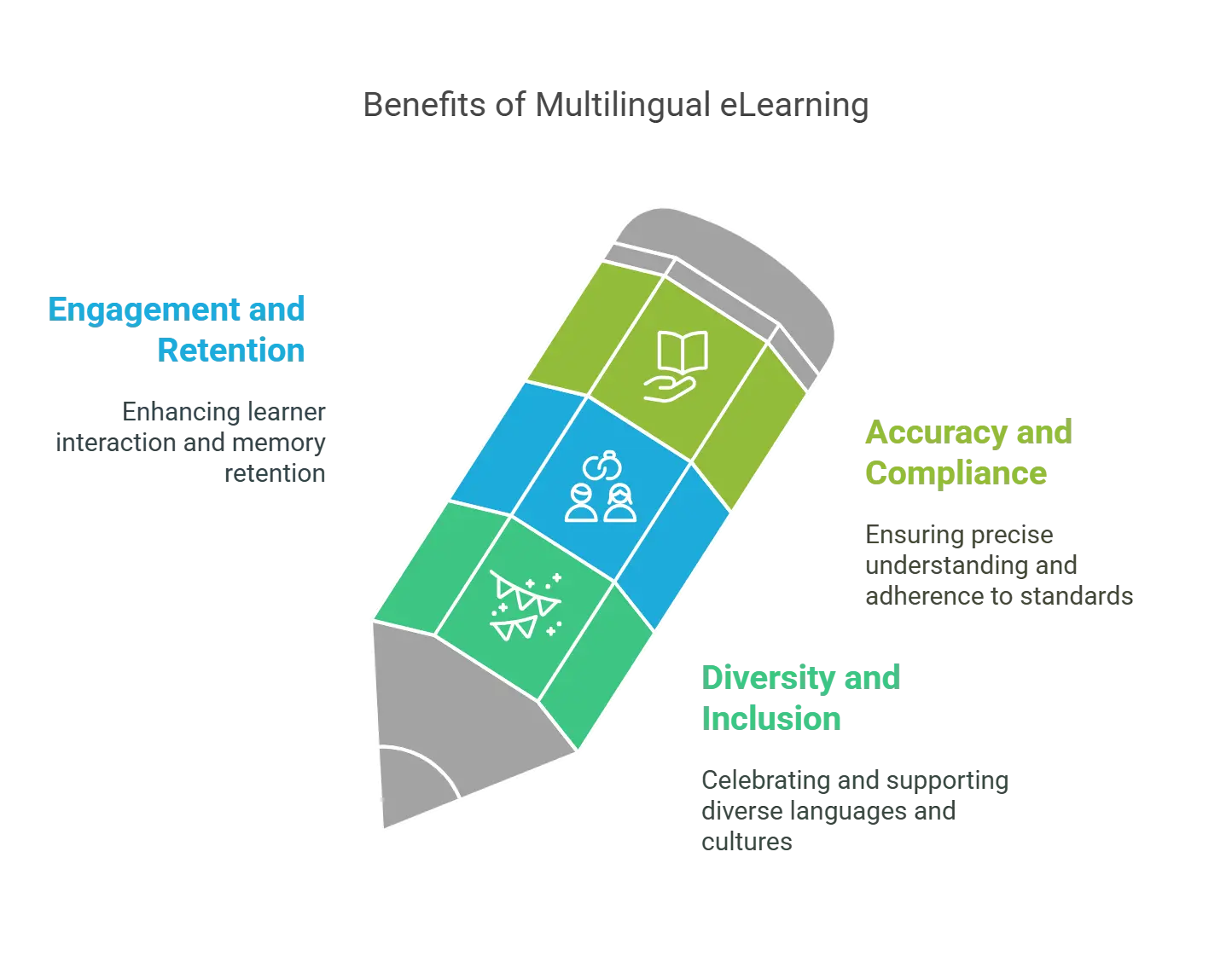
Make Your Training Global with Smart eLearning Localization Strategies
Summary
UNESCO’s 2022 insight highlights, “Education in the mother tongue is a key factor for inclusion and quality learning, and it also improves learning outcomes and academic performance.” This principle extends beyond traditional education into multilingual corporate training, where leveraging employees’ native languages can enhance engagement, comprehension, and overall learning effectiveness.
About 40% of the world’s population does not have access to education in a language they understand! And there are 6909 languages spoken in the world!
While we may have made a mistake regarding education in schools and colleges, we can rectify that through our corporate training localization programs by making them multilingual and adapting our eLearning modules. There is enough said about globalization.
Nowadays, global companies can expand their reach to several nations with local talent. Companies can access skilled individuals familiar with the local culture, language, and business methods.
However, corporate training localization has become a need among multinational firms to incorporate new and existing employees within this global framework. The strategy allows businesses to adapt their training programs to account for the local nuances of a culture.
This localization impact makes all employees feel appreciated and increases their engagement. Although the practice has picked up globally, many companies still find it hard to conduct training evaluations.
Let’s talk about what localization can do for your organization.
Table of Contents:
- What is Multilingual Corporate Training Localization?
- Why Adapt eLearning Modules for Multilingual Corporate Training?
- How to Adapt eLearning Modules for Multilingual Corporate Training?
- Top Benefits of Using Corporate Training Localization
- Measuring Localization Impact on Corporate Training Success
- How Corporate Training Localization Can Boost Revenue?
- In Conclusion
What is Multilingual Corporate Training Localization?
Corporate training localization goes beyond simple translation of the eLearning language into local languages. It is an “adaptation” where cultural beliefs, norms, social practices, local laws, different branch policies, etc., are also considered.
It includes localizing all kinds of training materials, including videos, audio, text, and everything that is used for eLearning.

Why Adapt eLearning Modules for Multilingual Corporate Training?
The right question is, why not? Over 60,000 multinational corporations worldwide operate more than 500,000 subsidiaries. While every employee undergoes training (which also reduces turnover rate), having one standard, global training module might not lead to your desired result.
Here are the three primary reasons why you should adapt your eLearning modules to multiple languages:
1. To Celebrate and Support Diversity and Inclusion
Welcoming people from different parts of the world into your workforce can be done easily by making the training content available in a language they are comfortable with.
Their cultural practices can also be accounted for (for example, by avoiding mentioning words that may be acceptable in a certain country but looked down upon in another). It can also improve contextual understanding.
2. To Increase Engagement and Retention
Through language localization, the training content resonates more with your workforce. The retention rate also increases, which means the learning outcomes are more favorable for the company.
Another obvious benefit of translating training materials is that your employees learn much faster due to this cross-cultural training.
3. To Improve Accuracy and Compliance
This example best demonstrates how corporate training localization can improve the accuracy of your eLearning content.
If a training module shows two people greeting as one of the accepted ways of non-verbal gesturing at the workplace, your Indian, Chinese, or Japanese employees might not feel included.
The ways of greeting people in those countries are different. It also allows you to include the local laws of the region, where providing training materials in the local language is mandatory.

How to Adapt eLearning Modules for Multilingual Corporate Training?
Here are a few best practices you can follow to adapt eLearning modules for corporate training localization in your organization:
1. Build a Strategy
Why are you undertaking a localization program? Is it because everyone else is doing it? Define your reasons and goals clearly.
This will make sure you can align your strategy to those while they work as a tether in the long run. Conduct thorough market research and gather as much information as you can.
2. Understand the Locale
Take Spanish, for example. It’s different in Spain and Mexico. Find out the dialect and what is culturally important for your employees to adapt it correctly for your target audience.
It could be the little things like slang, text size or direction, slogans, colors, imagery, currency, date and time formats, etc. Pay attention to these things.
3. Look at the Logistics
Ask important questions about implementing localized training. Does that office have the capabilities or tools? Do you have the resources to spend on cross-cultural training? How much time do you need to plan to implement it?
Think about the personnel you need or any localization partners. Decide on a translation technology you are going to use. Assign responsibilities, set timelines and a budget, establish a review strategy, create a quality assurance procedure, etc.
4. Dive into Data
Once you have localized your eLearning modules, track the performance metrics.
Look at the engagement rate, completion rate, retention rate, feedback, and, above all, if it has filled the knowledge gaps while promoting inclusion. Use this data to improve further and continue translating training materials.
5. Hire an Expert
The eLearning experts can completely customize your training modules for you, and they are state-of-the-art.
A localization partner’s expertise, experience, understanding of the different markets, technical abilities, etc., can make corporate training localization much more effective, efficient, and fast-paced.
It can also ensure that your training modules are regularly updated, glitch-free, easy to use, and, if required, uber-personalized.
6. Consider the Pareto Principle
Also known as the 80-20 rule, the Pareto Principle states that 20% of effort can result in 80% of goals. This means localizing 20% of your content could give 80% of the results.
Identifying the core 20% of your corporate training modules and starting with that is a smart choice. After measuring the results, you are free to localize 100% of the content. It won’t take as much resources or time since you’ll know the direction.
Comienza Ahora. 现在开始. अब शुरू करो. Start Now!
That was Spanish, Mandarin, and Hindi (and English, too), if you were curious.
And if you don’t understand one or two of those languages, you’ll find yourselves in the shoes of employees who undergo unlocalized training. This further highlights how important corporate training localization programs are. Companies like Netflix, ASOS, and Nintendo, among others, are already leading the way.

Top Benefits of Using Corporate Training Localization
From hiring diverse talent and integrating them efficiently within the workplace to establishing connections with the local population, corporate training localization proposes numerous advantages.
Take a look at some of the most prevalent ones:
1. Promotes Inclusivity and Diversity
An approach designed to teach local employees shows your dedication toward them. It shows the workers that you care for their growth and progress.
It creates inclusivity among peers and improves their learning outcomes. A localized training approach can also lead to employee longevity by exuding a sense of belonging.
2. Better Learning Opportunity
Learning is the core of corporate training. Employees view training programs as constructive, with 75% showing a willingness to take courses recommended by their managers.
Investing time and resources in your employees’ training ensures they get the best learning opportunity. Learning something in the native language will help them grasp the concepts quickly and accurately.
Remember that translation and localization are pivotal in workforce learning under foreign pretexts.
3. Maintain Standardization and Accuracy
Maintaining the same product quality is crucial for globalized companies.
With localization strategies, companies can maintain the effectiveness of multilingual corporate training. The quicker your workers get acquainted with the processes, the quicker they can start and produce results.
It helps businesses to maintain the quality of their standards across multiple markets. Also, catering your product to a local audience can work wonders, as 76% of consumers prefer products with information in their native language.
4. Improves ROI on Localization
Well-trained employees can improve your ROI in the region. With proper training, they can enable:
- Better customer experience
- Consistent brand messaging
- Quick response to issues
- Better productivity
Also, increasing your team’s skillset will lead to more satisfied stakeholders, ultimately elevating the overall ROI.

Measuring Localization Impact on Corporate Training Success
Assessing the success of corporate training localization is challenging since it cannot be calculated in numbers alone.
It includes non-quantifiable factors, such as cultural integration and team synergy, that make training evaluation even trickier. However, it can be measured by focusing on some key points.
Here is how you can assess the corporate training effectiveness of your localized program:
1. Measure Defined KPIs
Start by setting Key Performance Indicators (KPIs), such as learner engagement, knowledge retention, and satisfaction.
Assessing these KPIs can help you evaluate the effectiveness of the training. To get an objective comparison, conduct a pre- and post-training assessment. This can be done via surveys and evaluations of training completion and participation rates.
2. Undertake Performance Tests
One simple way of analyzing corporate training effectiveness is by comparing team members.
For example, you can separate two sets of employees: a) those who have undergone localized training and b) those who have not.
Ask both groups to perform standard tasks related to the company processes. A thorough analysis of the differences between their work will provide useful insights into the training’s effectiveness.
3. Ask for Feedback
One simple and direct way to gauge your localized corporate training’s effectiveness is simply by asking the employees.
Run interviews, group discussions, or surveys, whether it’s anonymous or transparent. The goal is to acquire their unfiltered opinion about the training program. It will also help you comprehend any changes needed to better cater to the local audience.
4. Consider Qualitative and Quantitative Results
You can also segment your analysis based on qualitative and quantitative results.
Measure the number of complaints, employee retention rate, and number of local customers. Also, consider your employee’s behavior, customer experience, and stakeholder satisfaction.
It will help you understand whether corporate training localization is effective.
5. Compare the Cost and ROI
Another clear method to establish the effectiveness of the training program is comparing the training cost and the ROI in the local market.
It will paint a distinct picture of what corporate training localization has achieved. Do not forget to consider customer satisfaction, frequency of errors and mishaps, and production metrics.
Also, employ methods like forecasting, control groups, a trend line analysis, etc. Merging the results of both assessments will give you an honest evaluation of how the training has affected the ROI.

How Corporate Training Localization Can Boost Revenue?
Here are nine ways corporate training localization can benefit your business:
1. Personalize Training Content
One of the key benefits of workforce localization is the ability to personalize training content for different audiences. By understanding the cultural nuances and preferences of learners in a particular market, organizations can tailor their training materials to resonate with the local workforce.
This includes adapting language, examples, case studies, and scenarios to make them more relevant and relatable to learners. Personalized training content helps create a stronger connection between learners and the training material, resulting in better engagement and improved learning outcomes.
2. Adapt to Local Workforce Needs
Localization in corporate training also involves adapting training programs to address the specific needs and challenges of the local workforce. Different markets have unique regulatory requirements, compliance standards, and industry practices. By incorporating these elements into the training curriculum, organizations can ensure learners receive the most relevant and up-to-date information. This helps learners acquire the necessary skills and knowledge and demonstrates the organization’s commitment to meeting local workforce needs.
3. Improve Learner Engagement
When training materials are localized and customized to suit learners’ preferences, learner engagement is significantly improved. Learners are more likely to be motivated and actively participate in training programs tailored to their specific needs.
Localization helps create a learning environment that is familiar and comfortable for learners, making them more receptive to new information and concepts. This increased engagement leads to higher knowledge retention and the application of skills in real-world scenarios.
4. Enhance Training Effectiveness
The effectiveness of corporate training programs is directly linked to their ability to deliver the desired learning outcomes. Organizations can use translation and localization services to ensure the material is relevant, meaningful, and applicable to the local context. This improves the transfer of knowledge and skills from the training environment to the workplace.
Learners are more likely to apply what they have learned when they can see the direct relevance and practicality of the training content. As a result, organizations can achieve higher training effectiveness and drive better business outcomes.
5. Boost Brand Image and Reputation
Localization in business is not limited to product or service offerings. It extends to all aspects of the organization, including training programs. When organizations invest in corporate training localization, it demonstrates their commitment to understanding and meeting the unique needs of different markets.
This commitment enhances the organization’s brand image and reputation, positioning it as a global player that values diversity and inclusivity. A positive brand image helps attract top talent, build customer trust, and gain a competitive edge in the market.
6. Increase Market Penetration
Organizations can increase market penetration in different regions by localizing corporate training programs. Training materials tailored to suit the local audience are more likely to resonate with learners and generate interest in the organization’s offerings. This can lead to increased demand for training programs, driving revenue growth. Additionally, localized training materials can help organizations establish themselves as industry leaders in specific markets, further expanding their market share and influence.
7. Expand Into New Markets
Corporate training localization opens doors to new markets and opportunities for organizations. When training materials are adapted to suit the preferences and requirements of different regions, organizations can effectively enter new markets with confidence.
Localized training programs help bridge the cultural and language barriers, making it easier for organizations to establish a presence and gain acceptance in new markets. Expanding into new markets can significantly contribute to revenue growth and long-term business success.
8. Improve ROI and Cost Efficiency
Investing in corporate training localization can improve return on investment (ROI) and cost efficiency. By adapting existing training programs for different markets, organizations can leverage their existing content and resources, reducing the need to create new training materials from scratch.
This cost-effective approach allows organizations to reach a wider audience without significant additional investment. Furthermore, by delivering more relevant and effective training programs, organizations can achieve higher ROI by ensuring that learners acquire the necessary skills and knowledge to drive business success.
9. Foster Cross-Cultural Collaboration
Corporate training localization enhances revenue growth and fosters cross-cultural collaboration within the organization. Adapting training materials to local contexts promotes understanding and appreciation for diverse perspectives and practices. This approach encourages employees from different regions to collaborate more effectively, share insights, and work cohesively on global projects.
By promoting cross-cultural collaboration, organizations can tap into the collective strengths of their diverse workforce, leading to innovation and improved business outcomes.
In Conclusion
Corporate training localization is a key part of modern organizations. The process lets businesses become acquainted with the local culture, find local talent, and expand their customer base.
While it is highly beneficial, it can pose challenges if you do not have the right approach. That is why choosing the right translation technology is crucial for efficient localization. It can help you find the right tone, contextualize material, and streamline the overall training program.
The ideal way to integrate localization into your corporate training is by partnering with an experienced workforce learning platform. Hurix Digital can equip you with the tools to deliver top-quality localization training. With Hurix, you will get the right solution tailored to your needs.
Want to get started? Contact us today to boost your corporate training localization efforts.

A highly enthusiastic and motivated sales professional with over twenty five years of experience in solution selling of training-related applications and services. Maintains an assertive and dynamic style that generates results. Ability to establish long-term relationships with clients built on trust, quality of service and strategic vision. Specializes in financial services, higher ed, publishing and government in the areas of learning and development.







